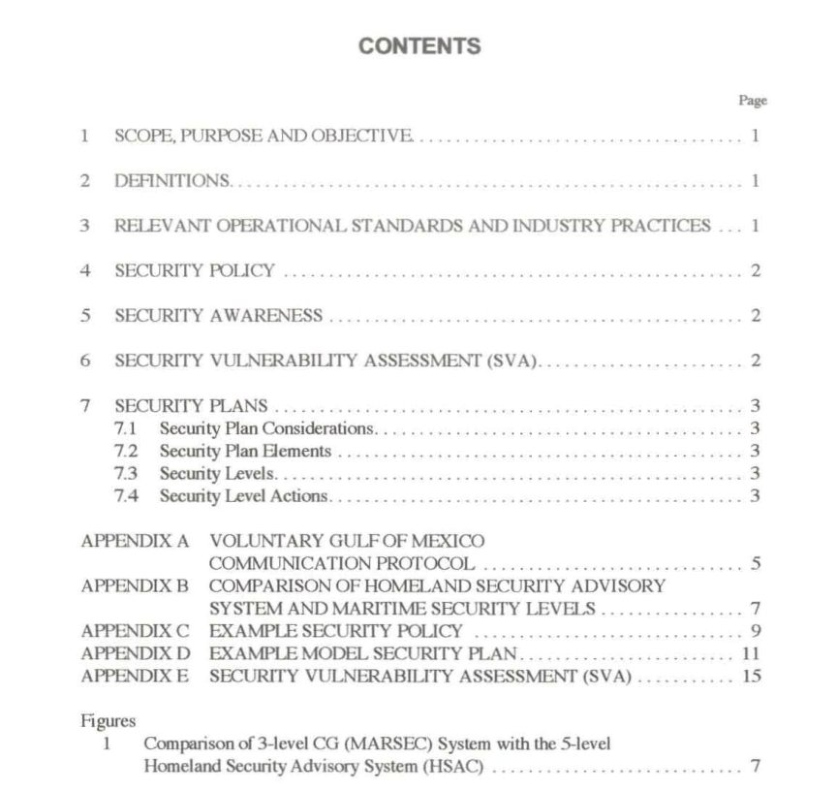API RP 70 pdf download

API RP 70 pdf download.Security for Offshore Oil and Natural Gas Operations
1 Scope, Purpose and Objective
This publication is intended to assist the offshore oil and natural gas drilling and producing operators and contractors in assessing security needs during the performance of oil and natural gas operations. The offshore oil and natural gas indus- try uses a wide variety of contractors in drilling, production, and construction activities. Contractors typically are in one of the following categories: dilling, workover, well servicing, construction, electrical, mechanical, transportation, painting, operating, and cateringjanitorial.
2 Definitions
2.1 company security officer (CSO): The CSO is responsible for the maintenance of the Security Plan. The CSO shall have access to relevant security information. The CSO shall determine which information, and by what means, it is communicated. The CSO may delegate duties as neces- sary to assure timely completion of responsibilities. The CSO may be assigned other duties and responsibilities unrelated to security. 2.2 contractor: The individual, partnership, firm, or cor- poration that is hired to do a specific job or service, such as a production operator, drilling or well servicing contractor or to provide contract employees to an ownerloperator, a contrac- tor is also the individual, partnership, firm, or corporation retained by the owner or operator to perform other work or provide supplies or equipment The term contractor shall also include subcontractors. 2.3 facility: Any artificial island, installation, or other device permanently or temporarily attached to the subsoil or seabed of offshore locations, erected for the purpose of exploring for, developing, or producing oil, natural gas or mineral resources. This definition includes mobile offshore drilling units (MODUs), but does not include pipelines or deepwater ports. 2.4 facility owner/operator: The individual, partner- ship, firm, or corporation having control or management of offshore operations. The owner/operator may be a lessee, des- ignated agent of the lessee(s), or holder of operating rights under an operating agreement 2.5 facility security officer (FSO): The individual that is responsible for security duties as specified by the owner/ operator at one or more facilities, depending on the number or types of facilties a company operates. Where a person acts as the FSO for more than one facility, it should be clearly identi- fied in the facility security plan for which facities this person is responsible. The FSO may be a collateral duty provided the person is fully capable to perform the duties and responsibili- ties required of the FSO. 2.6 point of embarkation: The heliport or dock facility from which personnel and materials are shipped to or received from the offshore facility. 2.7 security vulnerability assessment (SVA):A scc- ondary evaluation that examines a facility’s characteristics and operations to identify potential threats or vulnerabilities and existing and prospective security measures and proce- dures designed to protect a facility. 2.8 threshold characteristics: Criteria established and published by the U.S. Coast Guard for screening offshore facilities.
3 Relevant Operational Standards and Industry Practices
5.2 Facility owners/operators and contraclors should keep abreast of the latest security alerts and govemment intelli- gence information and disseminate this information, as appropriate, throughout the organization Facility owners/ operators should evaluate and respond appropriately to this information to safeguard personnel and assets. 5.3 Facility owners/operators should report, as appropriate, suspicious activities and behaviors, attempted incursions, ter- rorist threats, or actual events to the appropriate agencies. See Appendix A for an example communications prolocol devel- oped by the Gulf Safety Comite 5.4 Fach facility ownerl/operator should establish clear communication channels and procedures for assessing, pre- paring for, and responding to potential or actual threats. API and the oil and gas industry maintain a number of design and operational recommended practices that address aspects of safety and security in offshore oil and natural gas operations. While none of these were developed specifically for security reasons, aspects of them are directly applicable. In many cases, prudent safety procedures would also serve to address appropriate secunity precautions. These recom- mended practices provide a starting point for developing guidance on secunity, if needed, at offshore oil and natural gas operating facilities.









